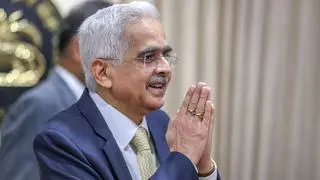With every passing day, India’s economic indicators are turning a little bleaker. The situation is bad enough to warrant using the word crisis, arriving just as the governments fiscal ammunition is spent.
The announcement Friday of 5 per cent GDP growth in the June quarter showed the economy growing at its weakest pace in six years. On Sunday, the top six car makers reported a 29 per cent drop in August sales,stoking fears that the slowdown could get still worse. The ₹98,200 crore ($13.7 billion) collected in August via the goods and services tax, the main tax on consumption, was the smallest in six months.
This adds pressure on the central bank both to cut its policy rate and to ensure that commercial lenders pass them on to borrowers. To the extent that the more inefficient public sector banks are a drag on credit, New Delhi said Friday that as many as 10 of them will be merged into four.
Read also: Govt banks on big bang mergers as GDP tanks
Whether folding one weak bank into another will make the combined entity any stronger remains to be seen. What’s clearer is that these lenders will spend the next six months on integration. Putting their balance sheets to work may take a back seat. Pending consolidation, the lenders might also be hesitant to issue new bank guarantees, especially to private-sector bidders for road projects. Thus, one of the few areas where there’s new investment may be affected, especially with a sharp rise in debt levels of the government agency that gives out the contracts.
A hefty injection of ₹55,250 crore of taxpayers money into the merged banks will only help them provide for the bad loans that will get lumped together. Capital for growth remains elusive. State Bank of India, the largest lender, will require ₹15,000 in the current fiscal year, according to ICRA Ltd., an affiliate of Moodys Investors Service.
Read more - August anguish: Auto sales skid further
The benefits will only be evident in a few years. The new round of consolidation will bring down the number of public sector banks to 12 from 27 just a few years ago. These lenders will have no choice but to become more competitive because they’ll have to price consumer loans by linking them to the central banks policy rate. Since they aren’t very good at lending against cash flows, the government wants them to originate loans together with non-bank financiers. Currently, even the shadow banks are stressed. Over time, though, this should help boost the underwriting standards of state-controlled lenders. Credit flows to smaller firms, which supply goods and services to larger companies,will improve.
Also read: India’s GDP growth pulled down by a perfect storm of factors
Making the most of vendor finance will require plugging India into global supply chains first. By offering the likes of Apple Inc. and Ikea less restrictive access to its billion-plus population, New Delhi is hoping for long-term sourcing wins from the rapidly deteriorating trade relations between Washington and Beijing.
But while taking much-neglected steps to position India as an alternative to China is a welcome move, the gains wont be immediate. Before committing to a new factory in India to both sell locally and to export, investors will want to see steadier final demand in the domestic economy. Maruti Suzuki, the nations biggest carmaker, is struggling to push out 100,000 cars in a month to dealers ahead of the festival season. That isn’t exactly a great advertisement to dangle before new entrants.
Good things will come from all the tinkering just not now. Weakening global growth means India cant even use a weak currency to export its way out of trouble. This isn’t the time to talk loudly about wanting to become the next China. A hawkish Washington won’t want to see mercantile strategies being deployed by yet another large labour-surplus nation.
Prime Minister Narendra Modi’s best hope will be to use the crisis to mend his governments frayed relationship with the private sector. Giving startups a reprieve from a seven-year-old law, one that was used by tax authorities to harass them with impunity, is a good move.
Admitting that there are design flaws in the consumption tax and fixing them perhaps by bringing separately taxed petroleum products into its ambit should be the next step. Like with the bank mergers, the gains will take time to become evident, even as the pain gets visibly worse.
Bloomberg Opinion






Comments
Comments have to be in English, and in full sentences. They cannot be abusive or personal. Please abide by our community guidelines for posting your comments.
We have migrated to a new commenting platform. If you are already a registered user of TheHindu Businessline and logged in, you may continue to engage with our articles. If you do not have an account please register and login to post comments. Users can access their older comments by logging into their accounts on Vuukle.